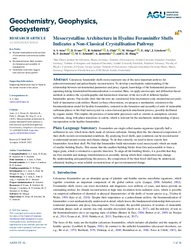Mesocrystalline Architecture in Hyaline Foraminifer Shells Indicates a Non‐Classical Crystallisation Pathway
Alig, E.
Schmidt, M. U.
Haug, G. H.
DOI: https://doi.org/10.1029/2022GC010445
Persistent URL: http://resolver.sub.uni-goettingen.de/purl?gldocs-11858/10169
Persistent URL: http://resolver.sub.uni-goettingen.de/purl?gldocs-11858/10169
Supplement: https://doi.org/10.17617/3.D7HN3I
Arns, A. I.; Evans, D.; Schiebel, R.; Fink, L.; Mezger, M.; Alig, E.; Linckens, J.; Jochum, K. P.; Schmidt, M. U.; Jantschke, A.; Haug, G. H., 2022: Mesocrystalline Architecture in Hyaline Foraminifer Shells Indicates a Non‐Classical Crystallisation Pathway. In: Geochemistry, Geophysics, Geosystems, Band 23, 6, DOI: 10.1029/2022GC010445.
 |
Dokument öffnen: |
Calcareous foraminifer shells (tests) represent one of the most important archives for paleoenvironmental and paleoclimatic reconstruction. To develop a mechanistic understanding of the relationship between environmental parameters and proxy signals, knowledge of the fundamental processes operating during foraminiferal biomineralization is essential. Here, we apply microscopic and diffraction‐based methods to address the crystallographic and hierarchical structure of the test wall of different hyaline foraminifer species. Our results show that the tests are constructed from micrometer‐scale oriented mesocrystals built of nanometer‐scale entities. Based on these observations, we propose a mechanistic extension to the biomineralization model for hyaline foraminifers, centered on the formation and assembly of units of metastable carbonate phases to the final mesocrystal via a non‐classical particle attachment process, possibly facilitated by organic matter. This implies the presence of metastable precursors such as vaterite or amorphous calcium carbonate, along with phase transitions to calcite, which is relevant for the mechanistic understanding of proxy incorporation in the hyaline foraminifers. Plain Language Summary:
Foraminifers are single celled marine organisms typically half a millimeter in size, which form shells made of calcium carbonate. During their life, the chemical composition of their shells records environmental conditions. By analyzing fossil shells, past conditions can be reconstructed to understand ancient oceans and climate change. To do that correctly, we need to know exactly how foraminifers form their shell. We find that foraminifers build micrometer‐sized mesocrystals which are made of smaller building blocks. This means that the smallest building blocks form first and assemble to form a larger grain, which is oriented in a specific direction. To align all the building blocks, it is possible that they are first unstable and undergo transformation on assembly, during which their composition may change. By understanding and quantifying this process, the composition of the final fossil shell may be understood, ultimately leading to more reliable reconstructions of past environmental change. Key Points:
Hyaline foraminiferal shells are built of micrometer sized mesocrystalline units.
Biomineralization likely includes the formation and assembly of nanoparticles.
Nanometer sized units suggest non‐classical crystal growth.
Statistik:
ZugriffsstatistikSammlung:
Schlagworte:
nonclassical crystallizationbiomineralization
amorphous calcium carbonate
precursor phases
organic matrix
nanoparticles
This is an open access article under the terms of the Creative Commons Attribution‐NonCommercial License, which permits use, distribution and reproduction in any medium, provided the original work is properly cited and is not used for commercial purposes.

